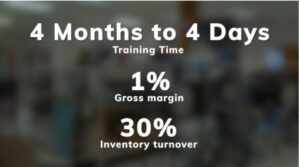How Technology and AI are Bridging the Labor Gap in Distribution
2023 Labor Shortages
Since the pandemic’s start three years ago, the United States has suffered a steep decline in members of the workforce. As of December 2022, Fed chair, Jay Powell, estimated a labor force shortfall of 3.5 million people compared to the Congressional Budget Office’s pre-pandemic forecast of growth. This participation dropped during the onset of COVID-19 due to sickness, fear of infection, etc. It was expected that this number would bounce back just as quickly as it had fallen, however the workforce is still suffering and wholesale distribution is no exception.
One of the biggest struggles employers are facing in trying to increase their retention numbers, is the high cost of recruiting, hiring, and training workers. Without employee satisfaction, top performers look for work other places, putting companies right back to square one. In distribution, it can take months to onboard a new employee. ERP systems are complex and product catalogs are lengthy to memorize. However, to truly succeed, customer service representatives (CSRs) must have a strong knowledge of the products and processes to use these products. With complicated ordering systems, CSRs spend more time trying to become experts in the system rather than product experts.

The Solution
The solution: invest in technology to streamline and simplify processes to best equip employees and allow them to better focus on customer interactions.
Building material distributor, Pacific Coast Supply, did just that and cut their employee training time down to just four days. “Labor shortage is where technology is coming in handy. We have a labor shortage, so let’s utilize technology & AI to help take away the clerical data entry parts of the job no one likes and use AI to expedite algorithm-driven searches for items,” said Michelle Pecak, Senior Director of Strategic Planning at Nature’s Touch Frozen Foods. “This combination enhances the customer’s experience and increases the employee’s value-ads which leads to higher job satisfaction. This paired with technology-driven communication between departments is a winning strategy!”

With 50 stores across the Western United States with over 6000 products, Pacific Coast Supply struggled with counter operations. They relied on making modifications to the SAP GUI in hopes of finding a solution.
Their order entry was inefficient and led to employee frustrations. The onboarding process was lenghty as it would take nearly four months to achieve proficiency in SAP GUI and more time was spent with the system than with the customer. As a result, Pacific Coast Supply’s growth was limited as time spent versus money earned was burdened. They struggled with in-store sales and store expansion.
With the onboarding of OMS+, Pacific Coast Supply found that it integrated seamlessly with their current SAP investment and nearly everything became easier, especially for new employees. “Investing in technology that will help improve the ease of the order entry process will not only lend to higher employee satisfaction,” Scott Walker, Chief of Staff at DataXstream said, “But also less order errors and faster time to money.”
The same level of proficiency and productivity was achieved with only 1-2 days of training in OMS+. “The visibility to real-time data meant Pacific Coast Supply could increase its inventory turns, open stores faster and achieve a faster time to money while delivering a better total experience for its customers and employees,” said Martin Menard, CIO of Pacific Coast Companies, Inc. Pacific Coast Supply was able to achieve things in six months they could not do in 20 years, all because of updates to their technology systems. They’re turning over inventory faster and as a result, more and more customers are coming to them.
Investments in technology are investments in employees – every business’ largest and most important asset.
Visit DataXstream.com for more information.






